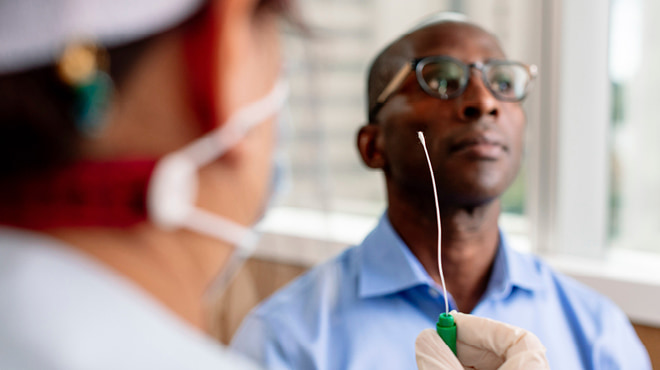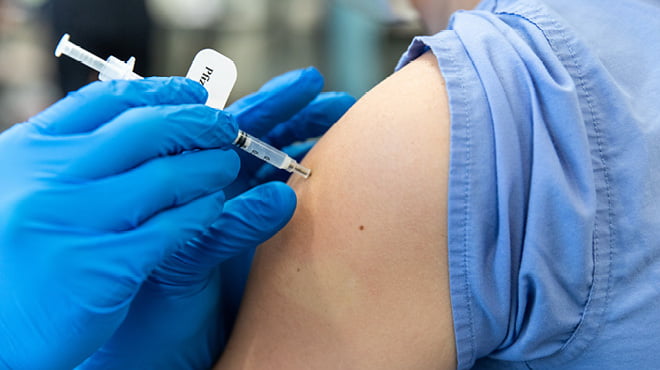Recent Posts
-
 Patient StoriesA lifesaver saved: An EMS veteran’s journey from rescue to recoveryNovember 14, 2025
Patient StoriesA lifesaver saved: An EMS veteran’s journey from rescue to recoveryNovember 14, 2025 -

-

Family warns others to take COVID-19 seriously

Mike Wolf was a healthy guy. He did not have any chronic health issues or conditions and saw his doctor once a year for annual checkups. That changed when he started feeling ill on May 17.
The Strum, Wisconsin, resident developed a constant cough and generally felt unwell so he went to get a COVID-19 test in Arcadia, Wisconsin. A few days later, Mike's results came back positive.
The family had been careful to follow recommended safety precautions during the COVID-19 pandemic because Brandi Wolf, his wife, had an underlying health condition that placed her in a high-risk category. The family believes Mike contracted the virus while at work.
"Our family has been pretty much isolating since March," explains Brandi. "We stayed out of stores, the kids were home from school and we only went to work."
Mike temporarily moved into the family's basement to remain quarantined from the couple's three children.
Although they were carefully washing their hands, maintaining social distancing and sanitizing areas of their home, Brandi began feeling ill about one week later and also tested positive for COVID-19.
"For two weeks, we started feeling better," says Brandi. "We had been in contact with the Trempealeau County Health Department, and they were going to release our family from quarantine on June 2."
That evening, however, Mike began experiencing severe pain in his legs and was having trouble walking. Brandi took him to the Emergency Department at Mayo Clinic Health System in Osseo, Wisconsin, where he was met at the door with a wheelchair due to the pain in his heel and swelling in his legs. He was evaluated by Raneau Myhre, a physician assistant.
"Even though heel pain and leg swelling were his initial complaints, we were more concerned with his respiratory status. He was not visibly short of breath and was speaking in complete sentences, but his color was gray," says Raneau. "His initial vitals showed a pulse oxygen saturation level of 58% on room air. Typically, people become short of breath when this value drops to below 90%. It's at that time the person requires supplemental oxygen. When asked about skin changes or rashes, Mr. Wolf admitted to discoloration of his fingers and toes, stating they would turn gray or blue at times. This was consistent with decreased oxygen saturation in his extremities."
According to Raneau, COVID-19 is known to increase hypercoagulability, or stickiness of the blood, which increases the risk of clots in the lungs and legs. A CT scan showed multiple clots throughout Mike's lungs, and an ultrasound confirmed blood clots in his legs that were causing the pain and swelling.
That evening, Mike was transferred by ambulance to the Critical Care Unit at Mayo Clinic Health System in Eau Claire, Wisconsin. The next day, Jeremy McBride, M.D., an interventional radiologist, placed a filter in Mike's inferior vena cava, which is the vein that carries blood from the legs back to the heart. This was done to decrease the risk of more large clots breaking loose in his legs and traveling to his heart or lungs. He also was placed on blood thinners.
During this time, his breathing continued to worsen, so the decision was made to place him in an induced coma and on a ventilator to help with his breathing.
"In some patients with severe respiratory failure, invasive ventilation is required to control their breathing completely. This was done here with Mr. Wolf being intubated with a plastic tube placed in his windpipe, and then he was connected to a mechanical ventilator," says Adel Zurob, M.D., a pulmonologist and critical care intensivist who cared for Mike during his hospital stay. "He was completely sedated to allow us to control his breathing and provide adequate support without him fighting the ventilator."
Mike was placed in a facedown position while on the ventilator.
"This position allows the lungs to ventilate more evenly," says Dr. Zurob. "However, this procedure involves a lot of coordination by the nursing staff to watch for pressure sores and ulcers, and also care not to have any lines or tubes disconnected in the process of turning the patient."
While Mike was in the hospital, Brandi experienced milder symptoms of COVID-19 and was able to manage her illness from home.
"It was really hard on all of us during that time," says Brandi. "We couldn't visit him in person because he was still testing positive for the virus. Our two older kids were scared, but didn't really understand what was happening. It was hard trying to explain it all to them."
Brandi and the kids remained connected to Mike virtually. The nurses called Brandi with updates multiple times every day, and she monitored his vitals from home using Patient Online Services, a free, secure online resource that connects patients to their health care teams. The nurses also would place Brandi on speakerphone in Mike's room so she could talk to him and the care team.
"The emotional toll this disease places on family should never be underestimated. It is very difficult to have a sick patient in the ICU with high risk of death and not be able to visit or hold," says Dr. Zurob. "Our team is able to leverage technology to alleviate some of this. Throughout the COVID-19 pandemic, our nurses and advance-practice providers have done a phenomenal job of keeping families updated and helping them connect virtually with loved ones."
Mike remained on the ventilator for 11 days. During that time, it was necessary to place a tube in his lung to drain fluid and blood. Gradually, Mike was showing signs of improvement, and he was able to be taken off the ventilator. On June 21 ― Father's Day ― he and the kids connected via Zoom.
After 43 days in the hospital, Mike was discharged on July 15 — just in time for his 40th birthday later in the week. He says that he is glad to be home, but he has a long recovery ahead, including ongoing physical therapy to build up lost strength. He hopes to return to work in February ― 10 months after contracting the virus ― but he is taking it one day at a time.
The Wolf family wants people to understand how serious the virus is.
"You never know who is going to get it lightly like I did or who will get it full force like Mike," says Brandi. "I want people to understand that you don't have to have underlying health condition to get really sick. Mike was 100% healthy before, and it almost killed him. I had an underlying condition, and I survived. You don't get a choice with this virus."
Raneau agrees.
"There is so much that we do not yet know about COVID-19. One of the biggest fears is that we do not know who is going to get very sick from the disease," she says. "Mr. Wolf was a healthy 39-year-old with no history of asthma, heart disease or smoking. Once he tested positive, he was treating his fever and symptoms appropriately. People who do get very sick from this disease tend to get worse about seven to 10 days after they are diagnosed. This was the case with Mr. Wolf."
A big factor in recovery from a serious illness is having a coordinated team approach, extending beyond the doctors and nurses.
"We should not forget the large number of respiratory therapists, nurse practitioners, environmental services staff, lab technicians, X-ray technicians, social workers and many others who participated in care directly or through the support they provide," says Dr. Zurob. "Without this teamwork, this happy ending would not have been possible."
Mike and Brandi want to thank the entire team at Mayo Clinic Health System.
"I know he wouldn't be here today recovering if it wasn't for the staff," says Brandi "Thank you from the bottom of our hearts."



